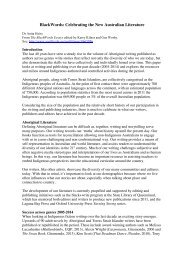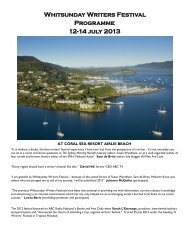7209743364812265548-Aboriginal-Literature-for-Children
7209743364812265548-Aboriginal-Literature-for-Children
7209743364812265548-Aboriginal-Literature-for-Children
Create successful ePaper yourself
Turn your PDF publications into a flip-book with our unique Google optimized e-Paper software.
Australian <strong>Literature</strong> (2002 and reprinted in 2007), lists “communication, consultation andconsent” as integral to producing the best <strong>Aboriginal</strong> literature possible. Importantly, evenwith such collaborations, copyright should rest with the <strong>Aboriginal</strong> parties—individuals ororganisations.One book that is an excellent example of the relationship between communication,consultation, consent—and a book that appeals to a wide audience—is the beautifullydesigned and presented Papunya School Book of Country and History (Allen & Unwin,2001). It is a text that has increased its readerships’ understanding and appreciation of thecultural value of <strong>Aboriginal</strong> authored children’s books.Papunya School Book of Country and History was created by Anangu staff and students atthe school in the Northern Territory, in collaboration with children’s author Nadia Wheatleyand illustrator Ken Searle. The book was developed as part of the school’s curriculumresources, and went on to be Joint Winner of the 2002 Award <strong>for</strong> Excellence in EducationalPublishing. The judges commented:The clarity and structure of the writing in Papunya provides, to readers of all ages,access to a very complex and complicated part of Australia's history. Developed as acollaborative project between staff, students and the authors, Papunya has crosscurriculumapplicability. Its holistic and innovative approach to learning helpsteachers and students to achieve a range of outcomes through study of the lives of thefirst Australians (qtd in Heiss 108).The development of the book involved, at times, as many as a dozen people producing onepicture, while the text was checked and re-checked by staff, and an early version of the bookwas trialed in the classrooms. The process of consultation between the community and thoseenlisted to assist the production process (Searle and Wheatley), demonstrates the culturallyappropriate way in which this publication was developed, a method that has ensured anaccurate, in<strong>for</strong>mative and valuable book went to the printer. Importantly, and in keeping withthe Writing Cultures protocols, copyright rests with the school.The Papunya School Book of Country and History is not just <strong>for</strong> kids though. The bookcrosses many genres, including non-fiction and biography, and is an attractive coffee table artbook. It is possibly also a “bible” of sorts <strong>for</strong> the community that lies 200 kilometres west ofAlice Springs, where the Anangu (the <strong>Aboriginal</strong> people of the central desert region) are thetraditional owners of the land, and where English and Luritja are spoken at school, with thelanguages of many countries spoken at home.It is a book of social importance because it contributes to improved understanding between<strong>Aboriginal</strong> and non-<strong>Aboriginal</strong> Australians. The work also functions as a history book andwon the 2002 NSW Premier’s Young People’s History Prize. The judges commented uponthe book’s historical significance:The Papunya Book of Country and History is a remarkable and long overduedeparture from the traditional model of history writing <strong>for</strong> young people. It offers notone voice but many, not one story but several; it builds a living bridge between agesand across cultures. This is a book that recognises the importance of both the visualand the written narrative in capturing young people’s interest in their past; its storiesand images are vivid and captivating, enriching and challenging. It offers nonIndigenous Australians (of all ages) a chance to learn from <strong>Aboriginal</strong> culture and




